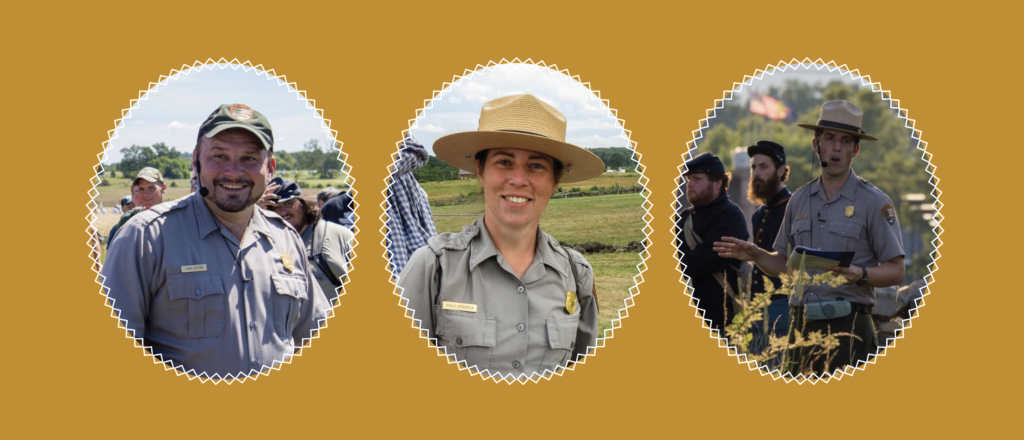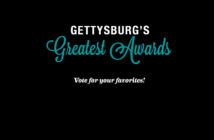Gettysburg Park Rangers Serve as Stewards of Hallowed Ground
By Lisa Gregory
There is something about the place.
For some, a visit to Gettysburg National Military Park sparks a fascination that will last a lifetime. For others, it continues to foster a love of and curiosity about the past. Then there are those who cherish the history of the place by becoming stewards of it.
These stewards include Gettysburg park rangers Chris Gwinn, who oversees the division of interpretation and education at the park; John Hoptak, an education technician; and Angela Atkinson, who oversees the licensed battlefield guides. For them, the work allows them to combine their love of history with their desire to share it with others.

“If you had asked me when I was 12 years old what I wanted to do with my life, I would have responded with exactly what I am doing right now,” says Gwinn. “Just the idea that I get to work on the battlefield. I am there every day. That’s my office.”
Fake Musket and Kepi
It all began with a visit.
Gwinn, then 6, was on a family trip from his home in Massachusetts to Washington, D.C. On the way, they made a couple of stops. “One was Hersheypark and the other was Gettysburg,” recalls Gwinn. However, it wasn’t the land of chocolate that made an impression on the little boy. It was Gettysburg. “I remember very clearly walking up on east Cemetery Hill and seeing the cannons and the monuments,” he says.
His future career path was set. “I loved the idea of working at a site where history was made,” says Gwinn, a graduate of Gettysburg College who has a master’s degree in public history.
A visit to the battlefield with family also entranced Hoptak, a Pennsylvania native with a bachelor’s degree in history and the author of several Civil War books.
“I was the kid who was running around with the fake musket and fake kepi,” Hoptak says. “I was the kid growing up through middle school, through high school, going to cemeteries in my home area and looking for graves of Civil War soldiers, or going to the library and trying to discover my local connections to the war.”
As for Atkinson—who also grew up in Pennsylvania, majored in history and minored in anthropology and journalism from Shippensburg University—it wasn’t exactly a visit to Gettysburg that inspired her interest in history. But it certainly fortified that interest. “Growing up, I was always the one to say, ‘let’s do all the history stuff,’” she says with a chuckle. “And I love the story of Gettysburg.”
Being There
For many park rangers, though, it isn’t enough to just know the story. They want the experience of being in the spot where history happened. “There is a tremendous power in a place,” says Hoptak. “I am still in awe when I walk the grounds. I get chills.”
As such, they want to share that experience with the 1 million visitors (pre-pandemic) who come to the Gettysburg park each year, whether it’s school students on field trips, families on vacation, or retirees traveling in RVs.
“You get interested by visiting a historic site or having an experience that really impacts you,” says Gwinn, who has worked at Antietam National Battlefield, Boston National Historic Park, and the National Mall and Memorial Parks.
At Gettysburg, a particular spot seems to especially speak to visitors. “I get a lot of questions about Abraham Lincoln and where he stood when he gave the Gettysburg Address,” says Hoptak, who also worked at Antietam National Battlefield. “There’s a lot of interest in those 272 words. People want to see the ground where he stood.”
And a visitor can have an impact as much as the place.
An individual on Gwinn’s tour group was a participant in the 1938 Civil War veterans’ 75th reunion at Gettysburg. “He was a Boy Scout, and he was brought in to help out with the reunion,” remembers Gwinn. “He was paired up with a veteran, a Confederate, who was 97 years old. He pushed him around in a wheelchair, and they talked about Pickett’s Charge. To hear that from the guy who heard it from the man that it happened to has this wonderful effect on putting history into perspective.”
An Evolving Story
And that perspective on history is evolving. As recent events have shown, Gettysburg can become a lightning rod for controversy, given today’s social and political environment, with the threat of protests and civil unrest at the site. But Gwinn, for one, embraces the challenge.
“I think there is not a better time to be a public historian working at a Civil War battlefield than right now,” says Gwinn. “Because what we are dealing with and what we are talking about is so incredibly relevant to what we are dealing with as a society today. What is the American Civil War about? It’s about the issue of race. It’s about who gets to be an American. It’s about the role of the federal government in the lives of everyday people. I see Gettysburg as a place where you can think about these ideas and talk about them.”
And that includes stories that haven’t been told before. For instance, the park is currently rehabilitating a historic home on the battlefield that belonged to James Warfield, a free African American man. “His home was taken over by the Confederate army, and he returned after the battle to find his property in ruins,” says Gwinn. “This is a man who lived 12 miles from Maryland, which, up until 1864, was a slave state. It’s a very evocative site. My hope is that everyone feels that Gettysburg is their story.”
Who Were These Soldiers?
It is the stories of the people, be they civilians or soldiers, that can sometimes have the biggest impact on both park rangers and visitors.
Many times, when military historians and enthusiasts come to the park, they want to focus on the maneuvers and strategies of the battlefield, says Hoptak. But he asks, “Who were these soldiers?”
Atkinson agrees. “Understanding that there were actually people who fought, who died, and comprehending the level of carnage can be difficult,” she says of the three-day battle with 51,000 casualties. “It’s hallowed ground. Many men lost their lives on this ground.”
Hoptak frequently shares with park visitors the story of the three Beaumont brothers, a coal mining family in Pennsylvania near Hoptak’s family home. “They served side by side,” says Hoptak of the brothers.
At Gettysburg, the youngest Beaumont was captured and sent to a Confederate prison only to die in another battle after he was released. Another brother, William, was shot through the neck and died at Gettysburg. The only one to survive and eventually make it home was George, but he was killed in a coal mine collapse while still in his 30s.
“The reason that story resonates with me is because my grandfather was 30 years old when he was killed in a coal mine collapse,” says Hoptak.
In fact, both men, George Beaumont and Hoptak’s grandfather, are buried near each other in the same cemetery. A personal connection for Hoptak can mean an invaluable connection for park visitors who hear the story.
“People remember stories like that,” he says. “They go home and remember them.”
Cursed Rocks and George Washington
But some visitors apparently are not only taking home stories.
Despite the gravity and significance of the subject matter, lighthearted aspects to the park rangers’ work do exist. Rocks, for example. They get rocks in the mail.
“We have lots of people who will take a rock from the battlefield,” says Gwinn.
It’s not a good idea. Not only is it illegal, but some tourists think the rocks are cursed after they take one home and experience bad luck. So, they often mail the rocks back to the park, “either because of some series of unfortunate events befell them or from their own personal guilt,” says Gwinn.
Then there are the questions, some a bit more unusual than others. “I’ve had people ask about George Washington or [Ulysses S.] Grant,” says Atkinson. “They get the wars and the battles confused.”
But all three rangers will tell you that a question, any question, is an opportunity to educate and inform, and it is treated with respect and encouragement.
“When someone comes in and asks what we refer to as a first-time visitor question, that is the moment that I think is most important,” says Atkinson, who before joining Gettysburg park worked for seven years at the Natchez National Historical Park in Mississippi. “You can foster that person’s sense of learning and a desire to return. You are laying a foundation.”
Speaking of questions, park rangers get a lot of them. Research is a part of the job. However, given the scope of the battle and number of people involved, new information is being discovered all the time. “We don’t have every piece of information,” says Atkinson. “Sometimes the best answer is ‘I don’t know.’”
But, in the spirit of a true history lover, park rangers such as Hoptak are anxious to go on the quest for the answer to that elusive question. “When I discover something, I can’t wait to share it with our visitors,” says Hoptak. “It’s that kind of passion that fuels us.”
And keeps history alive.




